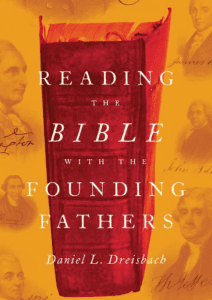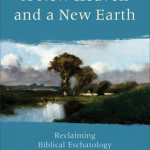We’ve been looking at the essays in a book Theology After Darwin centered around a simple question: What are the implications for Christian theology if Darwin was right? In conjunction with this we are also looking at three articles in the recent theme issue of the ASA Journal Perspectives on Science and Christian Faith (v. 62 no. 3 2010) Reading Genesis: The Historicity of Adam and Eve, Genomics, and Evolutionary Science.
Today I would like to look at the first part of the article by John R. Schneider “Recent Genetic Science and Christian Theology on Human Origins: An “Aesthetic Supralapsarianism”. We will look at more of this article, at the article by C. John Collins “Adam and Eve as Historical People, and Why It Matters“, and the chapter by John J. Jimson in Theology after Darwin entitled “Doctrines of the Fall and Sin After Darwin,” as we continue through the series.
 John Schneider obtained his doctorate in Divinity from the University of Cambridge and is a professor of religion at Calvin College, where he has taught theology for more than 25 years. In his article in PSCF he focuses on the historical and theological discussion of the interplay of science and biblical interpretation and on the doctrine of the Fall in the context of both scripture and science. In the post today I want to concentrate on the first issue – the historical context of the interpretation of Genesis within the history of the church. The place to start is with Augustine as his thinking has formed and informed much of the interaction between science and scripture in the western church.
John Schneider obtained his doctorate in Divinity from the University of Cambridge and is a professor of religion at Calvin College, where he has taught theology for more than 25 years. In his article in PSCF he focuses on the historical and theological discussion of the interplay of science and biblical interpretation and on the doctrine of the Fall in the context of both scripture and science. In the post today I want to concentrate on the first issue – the historical context of the interpretation of Genesis within the history of the church. The place to start is with Augustine as his thinking has formed and informed much of the interaction between science and scripture in the western church.
Augustine reflected at length on the book of Genesis, especially the early chapters on creation and his reflections have provided a foundation for much of the interaction between science or human reason and scripture for the last 1500 years or so. Dr. Schneider describes Augustine and the way he wrestled with the literal interpretation of Genesis, putting it in a context that is somewhat different than the context I’ve seen discussed in other places. This perspective frames the entire discussion of the interaction between science and scripture in a slightly different way. As we continue there are two questions to consider:
In what way should our understanding of science inform our reading of scripture?
In what way should our reading of scripture shape the way we look at the world?
Dr. Schneider’s describes the situation and context for Augustine and his interaction with Genesis:
In his great commentary on the “literal sense” of Genesis (Genesis Taken Literally), Augustine established (contrary to the majority of eastern theologians) the teaching that the literal human propositions of Scripture were all products of verbal divine revelation, and therefore literally true.8 In saying this, though, he was greatly concerned to avoid intellectually embarrassing and ignorant applications, such as the “flat-earth creationism” that had apparently become somethingof a popular movement among the unlettered Christian populace. These “flat-earth” (or, if you wish, “solid-ceiling”) creationists apparently read Genesis simply and (so they believed) literally to teach that the earth is a flat disk resting on an ocean and covered by a solid ceiling, or dome, that protects it from a second ocean up above. (We will notice the irony of this “ignorance” in a moment.) They used the Bible (mainly Gen. 1:6–8) to proclaim the superiority of revealed cosmology over pagan Greek teaching, which was that the earth was a sphere, and that the heavens could not be an ordinary solid, as the Bible said. Augustine knew that the Greek theory was almost certainly right, and he judged that these Christians were unwittingly conferring their own ignorance on sacred Scripture, and bringing disgrace to the Gospel itself. (p. 198)
Augustine was confronted with a situation where Christians were taking the teaching of Genesis 1 literally and bringing ridicule on the church and the faith for their view – not of human origins, but of cosmology. They believed that the earth was literally flat with a solid dome above as the ANE cosmology in Genesis assumes. This was a problem for Augustine. In this context he wrote in this commentary on The Literal Meaning of Genesis:
Usually, even a non-Christian knows something about the earth, the heavens, and the other elements of this world, … about the kinds of animals, shrubs, stones, and so forth, and this knowledge he holds to as being certain from reason and experience. Now, it is a disgraceful and dangerous thing for an infidel to hear a Christian, presumably giving the meaning of Holy Scripture, talking nonsense on these topics; and we should take all means to prevent such an embarrassing situation, in which people show up vast ignorance in a Christian and laugh it to scorn. … If they find a Christian mistaken in a field which they themselves know well and hear him maintaining his foolish opinions about our books, how are they going to believe those books in matters concerning the resurrection of the dead, the hope of eternal life, and the kingdom of heaven, when they think their pages are full of falsehoods on facts which they themselves have learnt from experience and the light of reason? (Vol. 1, CH. 19:39)
In response to the challenge of his day, in response to those who insisted that ANE cosmology must be correct because it is taught by scripture, Augustine formulated what has become a classic concordist approach to the relationship between science and scripture.
When they are able, from reliable evidence, to prove some fact of physical science, we shall show that it is not contrary to our Scripture. But when they produce from any of their books a theory contrary to Scripture, and therefore contrary to the catholic faith, either we shall have some ability to demonstrate that it is absolutely false, or at least we ourselves will hold it so without any shadow of a doubt. (Vol. 1 CH. 21:41)
Augustine was committed to scripture and in his view scripture must be correct. Thus when a fact is proven in science it, by definition, could not be in conflict with the literal meaning of Genesis. This approach was the foundation for the Catholic approach from Augustine to Galileo and Copernicus, and is the foundation for much Protestant wrestling with issues such as the age of the earth and the possibility of evolutionary creation. The irony here is that most scholars of ANE history today realize that those Augustine was criticizing were both correct – and incorrect. They were correct that the Ancient Near East (ANE) cosmology presumes a flat earth and a solid dome. They were incorrect in assuming that therefore the earth was flat and the sky was a solid dome. But Augustine’s view of scripture controlled the way he looked at the problem as well. It required that he deny the ANE context of Genesis and find a concord between observation, reason, and scripture.
Schneider points out that the fiasco with Galileo and the Copernican revolution has served to chasten the Catholic approach to the interaction of science and scripture. There is still a high regard for reason, a respect for science, and a profound respect for scripture as inspired by God, but there is a more guarded and realistic hermeneutical approach to the interpretation of scripture, especially with regard to science.
The protestant approach, especially among conservative Christians committed to sola scriptura and the perspicuity of scripture still has a way to go. But there is an important hermeneutical lesson here – one we would do well to remember. We should have a high regard for scripture as inspired by God and for the revealed nature of God in the world around us – but a “triumphal synthetic” rendering will misuse scripture and be subject to future correction as our understanding of the nature of God’s creation increases. The purpose of scripture is not to teach cosmology, biology, the history of creation, or even the material details of human origins. The scientific context of scripture – from Genesis through Revelation – is the cultural context of the day. This is apparent in the ANE cosmology of Genesis 1 and the context of Job to give just two examples. The purpose of scripture is to reveal God and his interaction with his creation and his people and it does not appear that he saw fit to teach science in this interaction. We learn science by exploration, not by special revelation; not because God could not reveal scientific detail in scripture, but because it seems clear that he did not choose to do so.
This has implications as we move on in the next post on Schneider’s article to consider Adam, Paul, and the Fall. Today, though, I would like to stop at this point and consider the lessons from Augustine and the interaction of science, human reason, and scripture.
Was Augustine right? Should we expect agreement between reliable evidence and facts of physical science and the literal reading of Genesis?
Does the veracity of scripture require this kind of agreement?
If not, why not? How should we view the relationship between science and scripture?
If you wish to contact me directly, you may do so at rjs4mail[at]att.net
You can subscribe to a full text feed of my posts at Musings on Science and Theology.










